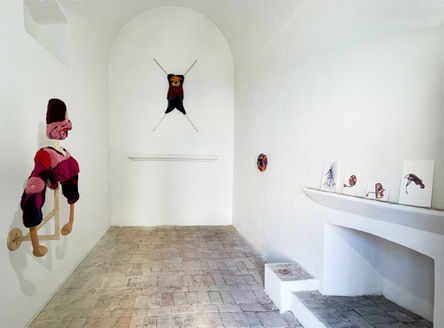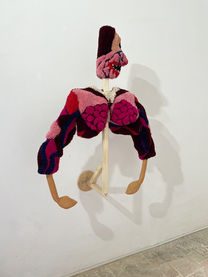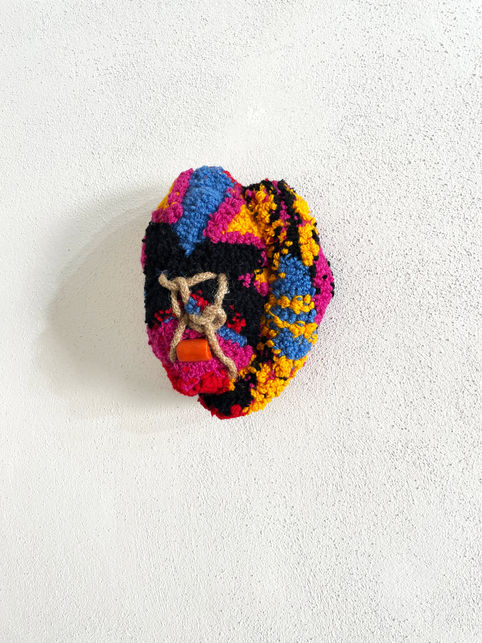ANNA PERACH

Anna Perach (b. 1985, Ukraine) lives and works in London, UK. She completed her MFA in fine art from Goldsmiths, University of London in 2020. Upcoming and recent shows include Anna Perach, Gasworks, London, UK (2024); Threads: ‘Breathing stories into materials’, Arnolfini, Bristol, UK (2023); UNRULY BODIES, Goldsmith CCA, London, UK (2023); Antigone, Richard Saltoun, London, UK (2023); Mistress of the desert, Almasan Gallery, with Gaston Zvi Ickowicz, Jaffa, Israel (2023); Raw Nerves, Hannah Barry Gallery, London, UK (2022); Myths of Observation, Hales Gallery, London, UK (2022); Body en Thrall, Rugby Art Gallery and Museum, Rugby, UK (2022); The Moon Prophecy, Herzliya Museum of contemporary art, Herzliya, Israel (2021); Tomorrow: London, White Cube, London, UK (2020); Mostyn open 21 shortlisted exhibition, MOSTYN, Llandudno, Wales (2019) and The Mother Art Prize 2019, Mimosa House, London, UK (2019). In 2020 she received awards from Carol Rama, Sarabande, The Lee Alexander McQueen Foundation and the Royal Society of Sculptors.
RESIDENCY: 8 - 30 AUGUST 2023
EXHIBITION: 1 - 5 SEPTEMBER 2023
Castello San Basilio is delighted to present The Nun’s Tit, Anna Perach’s end-of-residency exhibition, produced in collaboration with ADA, Rome.
Perach makes her sculptures using a tufting technique, the same ancient method used to manufacture carpets. Through this medium, she examines how textiles, more commonly associated with the domestic sphere, operate as an extension of the self and reflect one's heritage and gender role. Perach uses this method to transform female archetypes into sculptural works exploring ideas of identity, domesticity, intimacy and craft.
Perach’s works function both as garments, worn during her performances, as well as standalone sculptures. Playing with Castello San Basilio’s monastic architecture, which is characterised by high vaulted ceilings, the artist’s installation of the three new wall-mounted sculptures and watercolours series subtly evokes the interior of a church.
As you enter the room, you are confronted with The Rack, which Perach installed to suggest a crucifix. This sculpture depicts two identical sides of an abstracted female anatomy. Stretched on the wall by four metal chains, it references the mediaeval torture device. The bottom of the body splits into two tail-like shapes, reminiscent of the Melusine, the mediaeval European mythological creature, whose two tails symbolise female sexuality and duality. The torn figure echoes Julia Kristeva’s concept of abjection, whereby a baby ‘rejects’ the mother’s body to develop an independent sense of self. However, this natural, violent step leaves paradoxical scars; both a craving to return to the wholeness of the womb and a terror of once again losing the clear boundary of one’s individuality.
Your attention is then drawn to Untitled, a wall sculpture constructed from a tufted head and torso and ceramic hands mounted on a wooden stand. Its patterns are inspired by female anatomy, revealing muscle and bone. Addressing women’s objectification and sexualisation, this work explores the 18th century Anatomical Venus: the morbid, oversexualized, life-sized wax models of women designed to teach anatomy. Formed of layers that could be pulled apart to reveal detailed recreations of inner organs, they represented pregnant women with incongruously orgasmic expressions. The exposed organs and disassembled bodies of these sculptures confront the objectification of women, even in death.
Stick Head 2, mounted on the opposite wall, is part of Perach’s ongoing series of masks exploring Slavic mythology and folklore. Historically, these objects have been associated with religious ceremonies, employed for funerary customs, fertility rites, or the curing of sickness. Perach often asks her performers to ‘activate’ these masks by creating personal rituals inspired by movements associated with hysteria. The French neurologist Jean-Martin Charcot, devoted his life to treating women diagnosed with this ‘disease’. He believed that the physical and mental symptoms associated with Hysteria derived from the free movement of the uterus within the women’s body. Once again, the female body was viewed as one that transgresses the rules of morality and nature.
In all these portrayals of women, disparate themes converge around the female body and especially female reproductive system as a subject of fascination, fear, and the desire to control.
The Nun’s Tit, 2023




